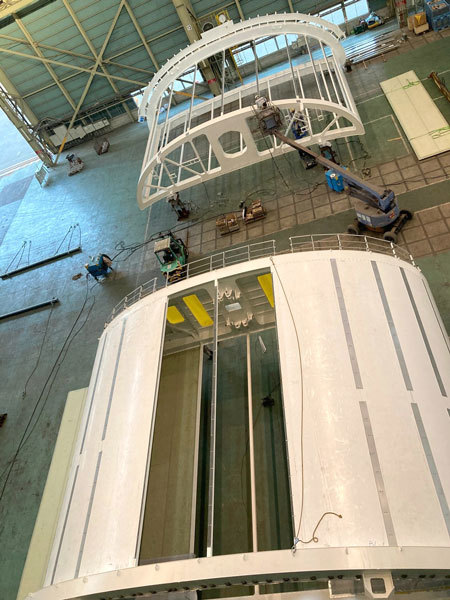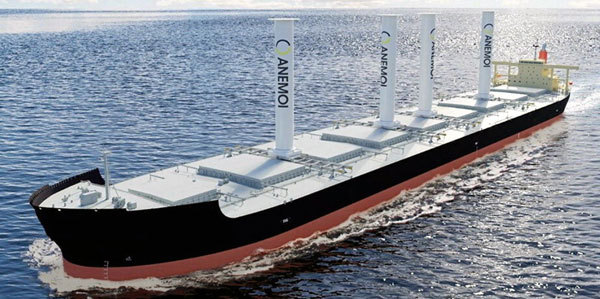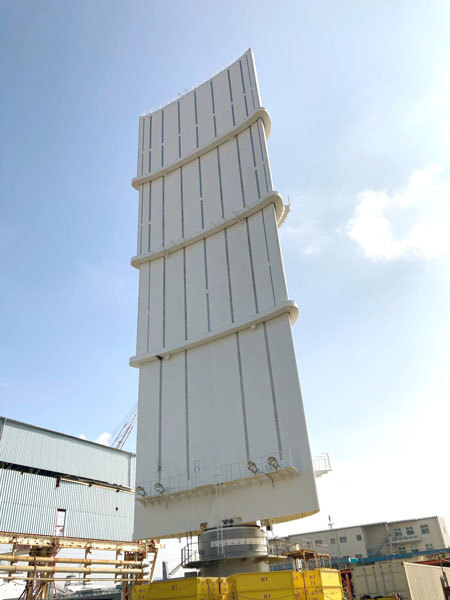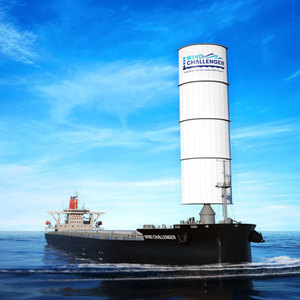Cutting Carbon Via Sails













PHOTO: MOL DRYBULK
August 25, 2022
BY Katie Schroeder
Industries across the globe have set goals to reduce their carbon footprint, and the pellet industry is no exception. Drax Group has the goal of becoming carbon negative by 2030 and is aggressively pursuing this ambition through a variety of endeavors. Most recently announced is a memorandum of understanding with Japanese company MOL Drybulk, to deploy what they have dubbed Environmentally Friendly Bulk Carriers, which will be developed in two generations. The first EFBC generation would deploy MOL’s Wind Challenger technology, shipping pellets to Drax’s overseas customers. In development since 2009, debut of the Wind Challenger technology is imminent—in fact, equipment for the first vessel, a 99,000-dead-weight-ton (DWT) ship, is currently being fabricated and assembled at Oshima Shipbuilding. The result of a deal with Tohoku Electric Power Co. Inc., it is scheduled for delivery in October, according to MOL.
Ross McKenzie, Drax Group director of international affairs, says use of MOL Drybulk’s technology aligns well with Drax’s zero carbon goals, adding that the company has already reduced its emissions by more than 99% through converting its Drax Power Station in North Yorkshire from coal to biomass. Doing so has made the company one of the lowest-carbon-intensity power generators in Europe, supplying 11% of the U.K.’s electricity. On top of that are the company’s carbon capture and storage (CCS) efforts, the most recent of which are the submission of plans to build the world’s largest CCS project at its power station, after piloting technologies for the past several years.
The green shipping initiative provides Drax with an opportunity to decarbonize even further, McKenzie says. He explains that the pilot of the project could deliver a 20% reduction in emissions and costs related to shipping Drax’s biomass from Canada to Japan, all while providing potential for decarbonization in the maritime industry. “International shipping is the backbone of the global economy, transporting about 90% of global trade volumes,” he says. “Shipping produces around 2.5% of the world’s total CO2 emissions. Reducing these emissions, while still having a vibrant global trading economy, is the goal, and green shipping initiatives like ours could play a significant role in achieving that.”
Wind Challenger Technology
The Wind Challenger sail technology has been in development for well over a decade, mainly by MOL and Oshima Shipbuilding, as an industry-academia joint research project led by the University of Tokyo. MOL took over in 2018, and has been working on the technology since. It received Approval in Principle from ClassNK for the design of the hard sail system in 2019, and was certified by Japan’s Ministry of Land, Infrastructure, Transport and Tourism earlier this year.
The hard sails can be fitted onto a variety of ships and are made from fiber-reinforced plastic, a light but strong composite material. The first challenger is being built with four sail tiers, each of which is approximately 15 meters (49 feet) wide and 20 meters high. The sails convert wind energy directly to a vessel propulsion force, automatically expanding, contracting or rotating in response to the situation—for example, contracting when entering or leaving a port and while berthed, without obstructing loading and unloading of cargo. Information and communications technology (ICT)-enabled, the Wind Challenger sails catch the wind in the most efficient way, according to conditions. They use Big Data to analyze sea conditions, weather information and a variety of other data to predict wind direction, saving energy by sailing along the most optimal route, choosing areas with the best wind.
MOL expects a vessel equipped with a Wind Challenger sail to reduce GHG emissions by about 8% on a route from Japan to the North American West Coast. However, with multiple sails combined with alternative fuels—the second generation of the EFBCs—emissions could be much further reduced. These vessels would be used to transport Drax’s wood pellets to Japan, estimated to decrease the carbon intensity of biomass shipping by a fifth, with the goal of putting the first vessel in the water in 2025.
Alongside its efforts in green shipping initiatives, Drax is looking to reduce carbon emissions throughout the supply chain with the development of the company’s Biomass Carbon Calculator, McKenzie explains. The tool is being used by other end users and biomass producers, and Drax expects it to become the most widely used tool across the industry. “[The calculator] allows companies to measure their supply chain emissions more accurately by using actual supply chain data,” McKenzie says. “This helps raise the quality of carbon accounting for the biomass supply chain and enables the industry to identify where emissions reductions can be made so the supply chain is as low carbon as possible.”
Not only is Drax exploring options for low-carbon transportation in the Pacific Ocean, but McKenzie tells Pellet Mill Magazine that the company has also been part of a 12-month feasibility study to find out how Smart Green Shipping’s wind-assisted sail technology could reduce the carbon emissions in shipping across the Atlantic Ocean. “The analysis, supported by the Innovate U.K. program, of retrofitting ‘FastRigs’ to an existing 83,000-metric-ton bulk carrier showed annual fuel and emissions savings of at least 20% per annum at the ship’s usual operating speed,” he says.
With carbon reduction being at the forefront of the climate change conversation, Drax's initiatives are a great example of taking action. The company’s methods to bring down its CI throughout both its supply chain and operations demonstrate how producers can view CI reduction holistically, rather than going all-in.
______________________________________________________________________________________________
Enviva has also partnered up with MOL Drybulk, in May announcing an MOU to deploy EFBCs. Following a successful joint study phase, the EFBC is scheduled for launch in 2024. It will aim to utilize rotor sail technology developed by Anemoi Marine Technologies Ltd. alongside MOL’s Wind Challenger technology, according to Enviva, which would both reduce emissions by harnessing wind energy, for an expected average GHG savings of about 20% in total. The 62,900-DWT vessel will be built by Oshima Shipbuilding.
______________________________________________________________________________________________
Author: Katie Schroeder
Staff Writer, Pellet Mill Magazine
kschroeder@bbiinternational.com
Advertisement
Advertisement
Upcoming Events





